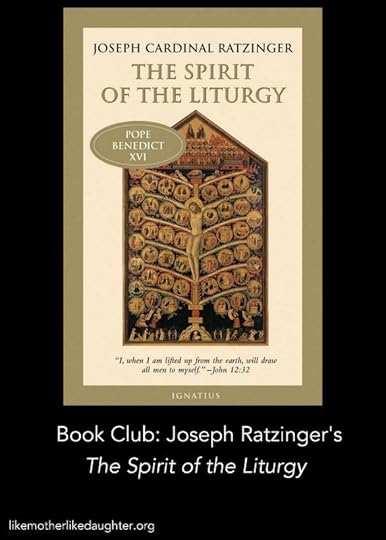The relationship of time and space in the liturgy ~ The Spirit of the Liturgy, a Book Club

{Book Club: The Spirit of the Liturgy}
I hope you will read along in this book club (or just read my posts, that’s okay): Joseph Ratzinger’s The Spirit of the Liturgy.
(When you buy something via our Amazon affiliate link, a little cash rolls our way… just a little. Thanks!)
I’ll post on Fridays, although for this longer book, perhaps not every Friday. I’ll give you your homework, I’ll talk about what we read, we’ll discuss in the comments. Even if you read later, the comments will still be open.
Previously:
Introduction to the reading: Joseph Ratzinger’s The Spirit of the Liturgy: A Book Club for Easter and Beyond
Nature or history in worship? Or both?
Homework: Read Chapter Two of Part II.
Chapter One, Part II: The Relationship of the Liturgy to Time and Space: Some Preliminary Questions
This chapter is not long and won’t take long to summarize.
I recently came across a dialogue on someone’s Facebook page that could serve as a jumping-off point for a discussion of this chapter — maybe it’s a question that you think about or that you’ve come across, namely, “Isn’t it enough that Jesus Christ died on the cross — as Scripture says, ‘Once and for all’?”
“It is accomplished,” he told us from the cross. The end. The rest of history is a working out of what that means for us, it seems.
Our task now, perhaps, is to remember and to imitate, and for this time and space exist.
Is that it? Ratzinger asks the same: On p. 53, “Is our divine worship not a matter of being loving people in our daily life?… Can there be any other holy time than the time for practicing love of neighbor, whenever and wherever the circumstances of our life demand it?”
There is truth in this way of looking at what it means to be a follower of Christ.
But… as I get older, I realize more and more that we can never be satisfied by that urge to summarize the meaning of life in “The One Thing You Need to Know” — There is no one thing! Our existence here on earth is precisely characterized by the tension of opposites (or seeming opposites) — the paradox of “opposing truth” that confronts us whenever we become comfortable with our formula, that “one thing” that will enable us to stop searching.
And indeed, if we pay attention to the Church’s Liturgical Year, the times she presents to us, time succeeding time, in which she takes the opportunity to spiral through all the “one things,” we undergo the challenge to our confidence that we have finally figured things out. The Year, containing all the commemorations and truths, presenting us to them all at once but also with different emphases, each enclosing at least the seeds of each, demonstrates that “And there are also many other things which Jesus did, the which, if they should be written every one, I suppose that even the world itself could not contain the books that should be written.” (John 21:25)
But I get ahead of myself.
Ratzinger here, in this chapter, wants us to know that the truth of this Event in the past shows us the “limits of human existence in this world” — the “not yet.”
Last week, as I was pondering this part of our book, we had the beautiful excerpt from St. Gregory the Great in the Office of Readings of the Liturgy of the Hours. Here is the complete reading for your consideration:
Since the dawn goes from darkness into light, it is right that the Church of the elect should be called “dawn” or “first light.” As it is led from the night of disbelief into the light of faith, it is opened up to the splendour of heavenly brightness just as the dawn bursts into day after darkness. How right are the words of the Song of Songs: Who is she who is coming up like the dawn? The holy Church seeks the rewards of heavenly life and is rightly called the dawn because it deserts the shadows of sin and sparkles in the light of righteousness.
There is something subtler to learn from this, on considering the nature of the dawn. Dawn, or first light, proclaims that the night is over but does not yet manifest the full brightness of the day. It dispels night, it gives a beginning to the day, but still it is a mixture of light and darkness. All of us who follow the truth in this life, are we not exactly like the dawn? Some of the things we do are truly works of the light, but others are not entirely free of the remnants of darkness. No man is virtuous before you, says the psalmist, and again Scripture says we have all done wrong in many ways.
This is why Paul does not say “the night has passed and day has come,” but night has passed and day is approaching, showing beyond doubt that he is still in the dawn, after the end of darkness but still before rising of the sun.
The Church of the elect will be fully day only when the darkness of sin is no longer mixed in with it. It will be fully day only when it shines with the perfect warmth of a light that comes from within. God shows that we are still going through this dawn when he says to Job, Have you ever sent the dawn to its post? Something that is being sent somewhere is being sent from one place or state to another. What is the destined place of the dawn if not the perfect brightness of the eternal vision? And when it has reached its place, will it still have any of the darkness of the night that has passed? The dawn was intent on reaching its destined place when the psalmist said My soul thirsts for the living God; when shall I appear before the face of God? The dawn was hurrying to the place it knew to be its destiny when Paul said that he wanted to die and to be with Christ, and when he said For me to live is Christ and to die is gain.
I had made a note of this reading at the end of the previous chapter, and then when I got to this one, here was the reference!
On p. 55, Ratzinger remarks on something I’m sure we’ve all experienced: how events of the past only have meaning when we look back on them in light of the experience when it is over. Memory is an essential, synthesizing component of understanding. So we have the events of the past, and then we have what he calls “the middle level,” which is the level of the liturgy — the “now.” But this “has meaning only in relation to something that really happens, to a reality that is substantially present.”
Far from being a fact of history that has disappeared into the past, that we can remember only with difficulty, Jesus’ sacrifice — his giving “inserted into the everlasting Yes of the Son to the Father” — the human will of Jesus united with his divine will — “draws the passion of human existence into the action of love… time is drawn into what reaches beyond time… time can again and again be brought into it. That is how we can become contemporary with the past events of salvation.” (P. 56)
Understanding this requires keeping in mind the perfect union of Jesus’ divine and human natures. This union is the hinge on which swings all of time and space — and eternity, from our point of view.
Not only is this union (the “hypostatic union,” you will remember) what makes us capable of being present for an event that seems past, it is what also brings the future into the now.
If past and present penetrate one another in this way, if the essence of the past is not simply a thing of the past but the far-reaching power of what follows in the present, then the future, too, is present in what happens in the liturgy: it ought to be called, in its essence, an anticipation of what is to come.
Not only the eschaton, the Second Coming; also the taking up of ourselves, whom the sacrifice represents — that in fact we may become a living sacrifice, that “his self-giving is meant to become mine.” Later on p. 58, Ratzinger says, “That is why, in the petitions for acceptance, we pray that representation become a reality and take hold of us.”
The once-for-all wants to attain its always.
I think you can see that this is a substantially different view of what goes on in church than the idea that we are hearing some motivating words about a holy man and spending some time thinking — or even praying — about them.
As he often does, thankfully, Ratzinger gives us a little summary of his points in this chapter, starting at the bottom of p. 59:
Firstly: The liturgy, as we saw, is characterized by the once-for-all, historical Pasch of Jesus — his Cross and Resurrection.
Secondly: The eternal enters into our present moment in the liturgical action (the Mass — the only way this is accomplished; there is no other claim to doing just this).
Thirdly: We grasp “the desire of the eternal to take hold of the worshipper’s life and ultimately of all historical reality. The immediate event — the liturgy — makes sense and has a meaning for our lives only because it contains the other two dimensions. Past, present, and future interpenetrate and touch upon eternity.” (P. 60)
And all of this is to say that we inhabit this “in-between” place, and it is “only mediated by the signs of salvation. We need mediation.” Why? because we are not in the dawn, in the light — not yet! We are in the dimness of the space between night (not seeing) and day (seeing face to face), as St. Gregory so beautifully puts it.
That means, then, that here and now is a place and time of images and symbols. We need the material, without being bound by it. Just as Jesus is true man and true God, and thus forms the bridge between heaven and earth, so we need the material world to be able to find and attain the eternal world.
We have to have a way to express the historical, the moment we inhabit, and the future: “a theology of symbols, which connects us to what is present but hidden.”
Ratzinger ends the chapter by giving us the answer to the question, “Do we still need sacred space, sacred time, mediating symbols?”
Yes!
“We do indeed participate in the heavenly liturgy, but this participation is mediate to us through earthly signs, which the Redeemer has shown to us in the place where his reality is to be found.”
I love how his last sentence is so earthy, so sign-wedded, so grounded not in a philosophical formulation but in a parable: “The Shepherd takes the lost sheep onto his shoulders and carries it home.”
Let us know in the comments what you made of this chapter. We love hearing from you!
(Emphases added in quotes are mine.)
Click here to see our previous discussion of Romano Guardini’s The Spirit of the Liturgy, which you can read free, online. You can also purchase it here, although be warned, this edition does not have the footnotes, which stinks .
.
The post The relationship of time and space in the liturgy ~ The Spirit of the Liturgy, a Book Club appeared first on Like Mother Like Daughter.



